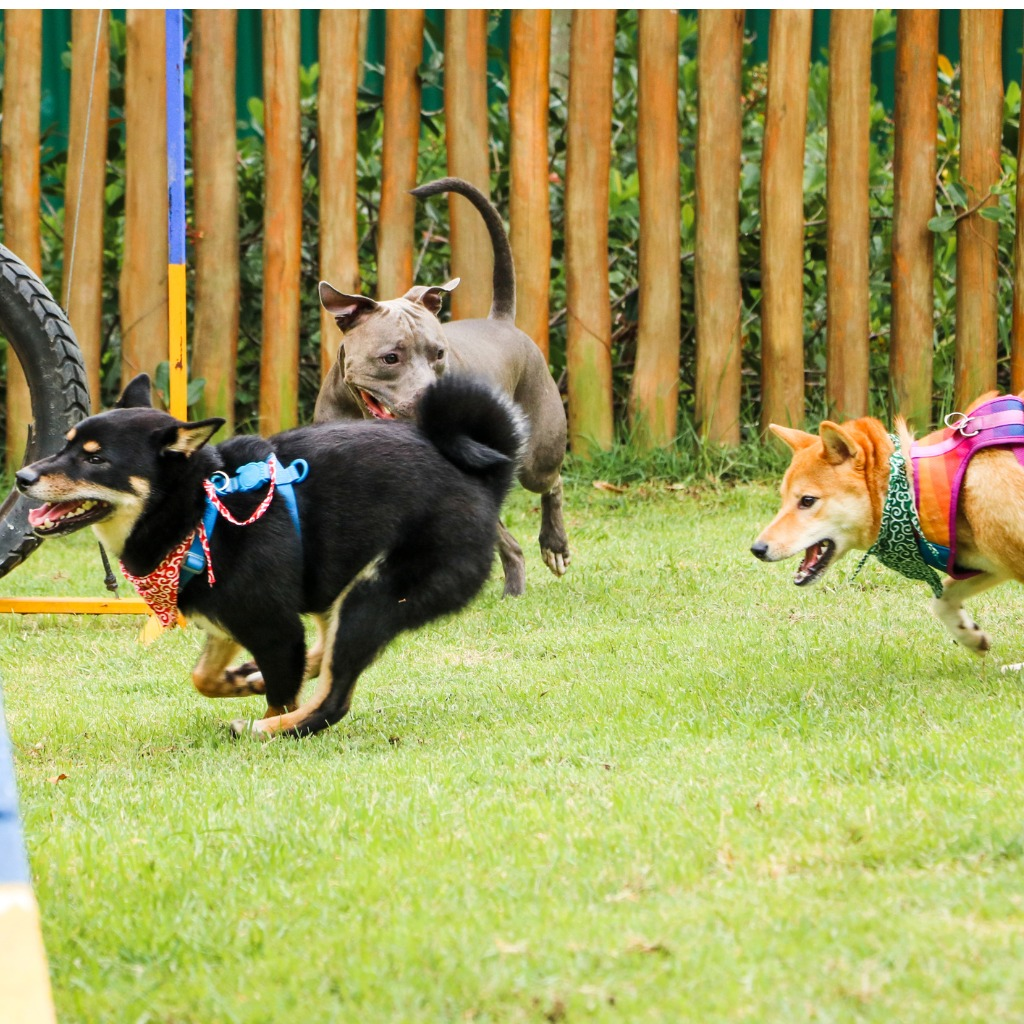Why Do Dogs Get the Zoomies? Exploring the Reasons Behind This Behavior

Have you ever witnessed your dog suddenly sprinting around the house or yard with a burst of energy, leaving you puzzled and amused? Welcome to the world of dog zoomies! This natural dog behavior can leave even the most experienced dog owner scratching their head, wondering, "Why do dogs get the zoomies?" This blog post explores the reasons behind this fascinating phenomenon and provides helpful tips for managing and understanding your dog's zoomies.
Short Summary
-
Understand your pup's zoomies and recognize common triggers!
-
Let their pent-up energy out with physical & mental activities.
-
Seek expert advice to ensure the safety & well-being of your pup!
Understanding Dog Zoomies
Zoomies, officially known as Frenetic Random Activity Periods (FRAPs), are sudden bursts of energy that dogs release in a whirlwind of excitement. The most common triggers for these zoomies include excitement due to a change in the environment, such as the arrival of a new toy or the release of pent-up energy after a long day of rest.
Zoomies are normal dog behavior, and understanding their triggers can help you better anticipate and manage your dog's zoomies.
Defining Zoomies
Frenetic Random Activity Periods (FRAPs) are the technical term for dog zoomies, characterized by unexplained bursts of energy in dogs. Pent-up energy and excitement are the primary causes of zoomies, leading to these unmistakable explosions of activity.
FRAPs are most common in puppies and young dogs, as they tend to have higher energy levels and a greater need to release pent-up energy.
Common Triggers
Zoomies can be triggered by various factors, such as the first thing in the morning, after spending much of the day in a cage, or post-bath excitement. These triggers can cause a buildup of energy, which is released in a big, exciting burst when dogs get the zoomies.
Identifying these common triggers can help dog owners predict when their furry friend might get the zoomies and take necessary precautions to ensure their safety.
The Role of Pent-Up Energy
Pent-up energy plays a significant role in causing zoomies, as dogs need an outlet to release their stored energy. To help reduce the frequency of zoomies, it's important to provide your dog with regular physical activities such as walks, trick training, and play.
Additionally, mental stimulation, like puzzle feeders, classical music, or watching the world outside, can contribute to keeping your dog's energy levels balanced and reducing zoomies occurrences.
Physical Energy
Physical energy is the energy stored in your dog's body, used to power their everyday activities. Zoomies are an excellent way for dogs to release their extra physical energy and nervous energy, giving them an opportunity to exert themselves and maintain a healthy energy balance.
By providing your dog with regular exercise, social interaction, and sensory enrichment, you can help reduce their physical energy levels, potentially decreasing the frequency of zoomies.
Mental Stimulation
Mental stimulation plays a significant role in your dog's overall well-being and can contribute to the occurrence of zoomies. Engaging your dog in mentally stimulating activities such as puzzle feeders or scenting games can help them burn off excess energy, reducing the likelihood of zoomies.
By providing mental stimulation in addition to physical exercise, you can help keep your dog's energy levels balanced and under control.
Age and Zoomies: Young Dogs vs. Older Dogs
Age plays a role in the frequency of zoomies, with younger dogs experiencing them more often than older dogs. Puppy zoomies typically occur during their 'witching hour,' usually early in the morning or between 5-8 pm.
While senior dogs can also experience zoomies, the frequency is generally less common due to their naturally lower energy levels. Understanding how age affects zoomies can help dog owners better manage and anticipate their dog's energetic bursts.
Puppy Zoomies
Puppy zoomies are energetic bursts that puppies experience, often zipping around in circles or zig-zags. These zoomies typically occur during a puppy's 'witching hour,' which is early in the morning or between 5-8 pm.
Puppy zoomies are more frequent and intense than adult dog zoomies, so it's essential to be prepared and provide a safe environment for your young furball during these energetic episodes.
Senior Dog Zoomies
Senior dogs can still experience zoomies but they occur less frequently than younger dogs. The frequency of senior dog zoomies may vary depending on the individual dog but generally declines as a dog ages.
Regular exercise, mental stimulation, and a safe environment can help ensure that your senior dog continues to enjoy their occasional zoomies without complications.
Zoomies as a Sign of Stress or Anxiety
Zoomies can sometimes indicate stress, anxiety, or fear in your dog. It's essential to read your dog's body language during zoomies and train them to end playtime when necessary to ensure their well-being.
By identifying and managing stress-related dogs, you can help keep them happy and healthy while allowing them to enjoy this natural behavior.
Identifying Stress Signals
To identify stress signals in your scared dog during zoomies, pay attention to their body language and look for signs such as wide eyes, tightly tucked tail, tense posture, or a head held low with ears folded back submissively. Recognizing these stress signals can help you determine if your dog's zoomies result from stress or anxiety and take appropriate action to ensure their comfort and well-being.
If your dog is exhibiting signs of stress during zoomies, it is important to reduce their stress levels. This can include providing a safe and comfortable environment with calming and anti anxiety dog beds, cozy blankets and engaging in calming activities such as massage or aromatherapy, and providing plenty of exercise and mental stimulation. Taking these steps can help your dog feel better.
Managing Stress-Related Zoomies
To manage stress-related zoomies, it's crucial to identify and address the source of stress. Providing your dog with physical exercise, mental stimulation, and social interaction can help reduce stress and anxiety.
Creating a safe space for your dog to run and play in, such as a room with a comfortable bed and white noise machine, can also help alleviate stress and minimize stress-related zoomies.
Safety Measures During Zoomies
It's essential to take safety measures when your dog has zoomies to ensure their well-being and the safety of those around them. Keep dogs away from stairs, slippery floors, obstacles, and the road, and provide a secure environment where they can safely release their energy.
Being proactive about safety during zoomies can help prevent accidents and ensure your dog can safely enjoy this natural behavior.
Creating a Safe Environment
To create a safe environment for your dog during zoomies, remove any potential hazards or obstacles in the area where they'll be zooming, such as furniture or sharp objects. Providing a safe space, such as a room with Cozy Waterproof Blankets and a calming dog bed and white noise machine, can also help reduce anxiety and stress during zoomies.
Avoid letting your dog zoom on hardwood floors or other slick surfaces to prevent potential injuries.
Handling Larger Dogs and Children
Supervising larger dogs closely during zoomies, especially around children, is crucial for ensuring their safety and the safety of those around them. If larger dogs have zoomies indoors, try luring them back with a treat or a favorite toy and slip a leash on them.
When larger dogs have zoomies outdoors, let them into the backyard to enjoy their zoomies safely, away from potential hazards and obstacles.
Tips for Reducing Zoomies Frequency
To reduce the frequency of your dog's zoomies, consider increasing their exercise, providing social interaction, and sensory enrichment. These activities help keep your dog happy and healthy and minimize the chances of them getting zoomies due to pent-up energy.
By incorporating these tips into your dog's daily routine, you can ensure they have a well-rounded and fulfilling life with fewer zoomies.
Increasing Exercise
Increasing your dog's exercise can help reduce the frequency of zoomies by burning off excess energy. Activities such as walks, fetch, tug-o-war, and learning new commands and tricks can help your dog expend their energy in a controlled and enjoyable manner.
Regular exercise helps manage zoomies and improves your dog's overall health and well-being.
Social Interaction
Social interaction is essential for reducing zoomies frequency and providing mental stimulation for your dog. Arranging playdates, taking your dog to dog parks, or walking around the neighborhood can help maintain your dog's social life and reduce pent-up energy that may lead to zoomies.
A well-socialized dog is more likely to be calmer and less prone to zoomies, which is beneficial for households with many dogs, including other dogs.
Sensory Enrichment

Sensory enrichment involves providing your dog with activities that stimulate their senses, such as sniffing new smells, exploring new places, or playing with different toys. These activities can help keep your dog mentally and physically stimulated, potentially reducing the frequency of zoomies.
By offering a variety of sensory enrichment activities, you can ensure your dog's energy levels remain balanced, and their zoomies are kept in check.
When to Consult a Certified Professional Dog Trainer or Vet
If your dog's zoomies become frequent or unusual, it's best to consult a certified professional dog trainer or vet for advice. Unusual behavior could indicate an underlying issue that needs to be addressed, such as stress, anxiety, or a medical condition.
By seeking expert advice, you can ensure your dog receives the appropriate care and support to maintain a happy and healthy life as a responsible dog owner.
Recognizing Unusual Behavior
Knowing your dog's natural behavior and recognizing any changes that may indicate a problem is important. Signs of unusual behavior in dogs include sudden aggression, inappropriate elimination, altered facial expression, or restlessness.
If you notice any changes in your dog's behavior, consult a certified professional dog trainer or vet to address any potential issues and ensure their well-being.
Seeking Expert Advice
When seeking expert advice regarding your dog's zoomies, it's essential to be specific and ask non-obvious questions about the behavior. Certified professional dog trainers and veterinarians can provide valuable insights and recommendations to help manage your dog's zoomies, ensuring their safety and well-being.
By consulting with experts, you can better understand your dog's behavior and take appropriate action to address any concerns.
Summary
In conclusion, dog zoomies are a natural behavior resulting from a sudden release of pent-up energy or excitement. Understanding the triggers, age factors, and potential stress signals can help dog owners safely manage and anticipate their dog's zoomies. Providing regular exercise, social interaction, and sensory enrichment can help reduce the frequency of zoomies and contribute to a happier, healthier dog. If your dog's zoomies become frequent or unusual, don't hesitate to consult a certified professional dog trainer or vet to ensure their well-being.
Frequently Asked Questions
Do Zoomies mean dogs are happy?
Yes, zoomies usually mean dogs are happy! Various experts have agreed that it is normal for dogs to express their happiness or excitement. Zoomies are also seen as a way of alleviating anxiety in certain situations.
Pet owners can easily identify if their pets' zoomies indicate joy or stress.
Are zoomies good or bad for dogs?
Zoomies can be fun for your pup and are usually nothing to worry about. However, if they become a problem, you should keep an eye out to ensure your dog is safe and isn't causing any damage to themselves or your home.
Zoomies are good for dogs as long as safety measures are considered.
Do zoomies mean a dog is tired?
No, zoomies don't mean a dog is tired. Instead, they usually indicate that your pup is excited and energetic.
It's important to monitor your pup when they have the zoomies so you can ensure they don't hurt themselves! So don't worry - enjoy your pup's adorable zoomies!
Why do dogs get the zoomies at night?
Your pup likely experiences Frenetic Random Activity Periods (FRAPs) or puppy zoomies at night due to excess energy they have built up during the day. Whether they need a few moments of playtime before bed, are worried about being separated from you, or are teething, this playful behavior helps them wind down for the night!
It is important to provide your pup with an outlet for their energy, such as a toy or a game of fetch. This will help them to expend their energy positively and will help them to relax before bedtime. Additionally, providing them with a calming dog bed from Animals Matter!
What are dog zoomies?
Dog zoomies are a delightful display of canine energy as your pup sprints around like a crazy whirlwind, full of joy and happiness!
It's a sight that will bring a smile and make you laugh out loud. Zoomies are a great way for your pup to release pent-up energy and have fun. They can also be used for other purposes.
Subscribe
Sign up to get the latest on sales, new releases and more…
Categories
- 5 Easy Organic Christmas Recipes for Dogs: Simple Holiday Treats Your Companion Will Love
- The 6 Best Luxury Gifts for Your Dog This Christmas: Thoughtful Holiday Comfort That Truly Lasts
- Why Playtime Matters: The Benefits of Mental Stimulation and Playtime with Your Companion
- Tails of Celebration: The Miao Dog-Carrying Festival - A Hero's Honor in China
- A Dog-Friendly Thanksgiving 2025: Comfort, Calm, and Easy Treat Recipes
- The Best Dog Beds for Winter 2025: 5 Luxury Styles for Warmth, Comfort & Orthopedic Support
- Tails of Celebration: The Feast of Saint Hubert — Belgium's Timeless Blessing
- Halloween Safety Tips for Dogs: How to Keep Your Companion Safe This Spooky season
- Tails of Celebration: Día de los Muertos / Day of the Dead for Pets, A Festival of Memory in Mexico
- How to Care for Senior Dogs in Fall: Mobility Tips & Joint Support
- Tails of Celebration: Kukur Tihar & The Tihar Festival of Nepal
- What is a VDI Testing for dogs ? : Insights, Procedures and Preventive Measures
- Cheap Dog Beds vs. Luxury Dog Beds: The Real Cost of a $50 "Disposable" Dog Bed
- Can Dogs Have OCD? Understanding Canine Compulsive Behaviors (CCD)
- Does My Dog Like Music? Find Out What Tunes Make Your Pup Wag!
- Effective Solutions for Food Aggression in Dogs
- 7 Frozen Treats Your Dog Will Love This Summer☀️🧊🍉
- The Best Waterproof Liners for Dog Beds: Protect Against Spills, Drool, and Accidents
- How to Cope with the Loss of a Dog: A Tribute to Every Companion We Carry in Our Hearts
- Top Tips on How to Prevent Matting in Dogs
- Understanding and Managing Dogs with Hip Dysplasia
- The Ultimate Guide to Dog Gut Health: Natural Remedies, Probiotic Insights and Signs of Poor Gut Health
- The Best Supplements for Dogs: Explore Top Picks for Canine Health and Wellness
- How Often Should I Brush My Dog's Teeth? Tips for Optimal Canine Dental Health
- Ultimate Guide on How to Comfort Your Dog During Fireworks this 4th of July
- Managing a Blowing Coat: Essential Grooming Tips for Double-Coated Dogs.
- 5 Daily Habits That Boost Your Dog’s Long-Term Wellness
- Mastering Crate Training a Dog: Tips and Benefits
- Dog Car Seats vs. Seat Covers: What’s The Best Option For Your Companion?
- Best Outdoor Dog Beds: Luxury, Durability, and Unmatched Comfort
- Is My Dog Overweight? Tips to Assess and Help Your Companion
- The Best Faux Fur Dog Beds for Ultimate Pet Comfort of 2025
- Dog Running Guide: How to Start, Train & Stay Safe when running with your Dog
- Indestructible Dog Beds? The Truth Behind the Term
- Top Tips for Effective Exercise for Dogs
- Effective Dog Ear Cleaning: A Step-by-Step Guide for Maintaining Healthy Ears
- How to Manage Dog Aggressive Behaviors: Expert Tips and Advice
- Effective Canine Ear Infection Remedies: Symptoms, Causes & Treatments
- How to Make a New Dog Comfortable in Their New Home - 2025 Guide
- Signs of Dog Allergy Symptoms and How to Help and Prevent Them
- Why Does My Dog Lick Their Paws? Causes and Solutions Explained
- Dog Alzheimer's: Symptoms, Causes, and Treatment Options
- The Legacy of Comfort with the Iconic Animals Matter® Ortho Companion-Pedic® Puff Luxury Dog Bed
- Orthopedic Square Dog Beds: The Ultimate Blend of Luxury, Comfort, and Support
- Loungers: The Ultimate Beds for Luxury, Comfort, and Orthopedic Support
- Square Dog Beds: Orthopedic Comfort and Stylish Designs for Your Companion
- Effective Solutions for Canine Incontinence: Identifying Causes and Best Treatments
- Ethical, Sustainable, and Certified: Why Certified Products Matter, Exploring CA Prop 65 and CertiPUR-US® Standards
- Dog Seizures: Signs, Causes, and How to Help Dogs with Seizures
- Celebrate National Dog Day: Here are ideas for Dog Lovers and a dive into the history of our canine companions.









Leave a comment
Please note, comments must be approved before they are published